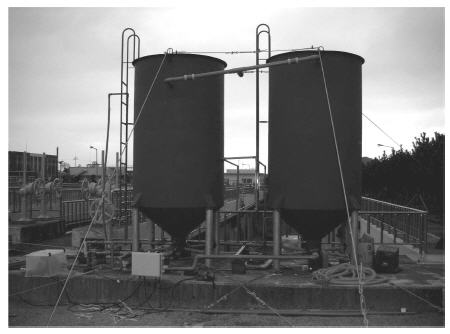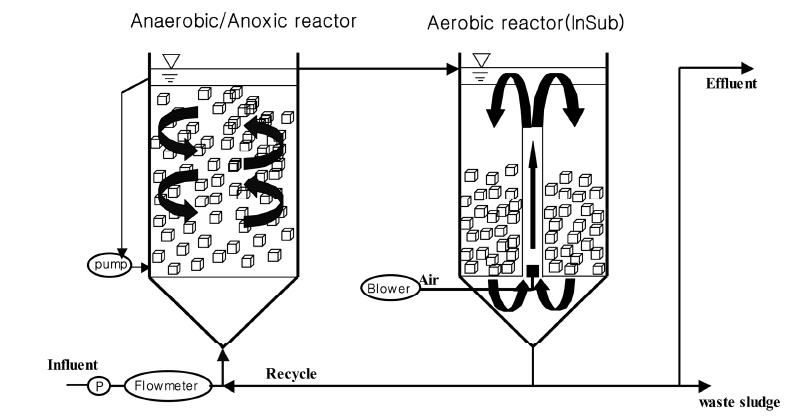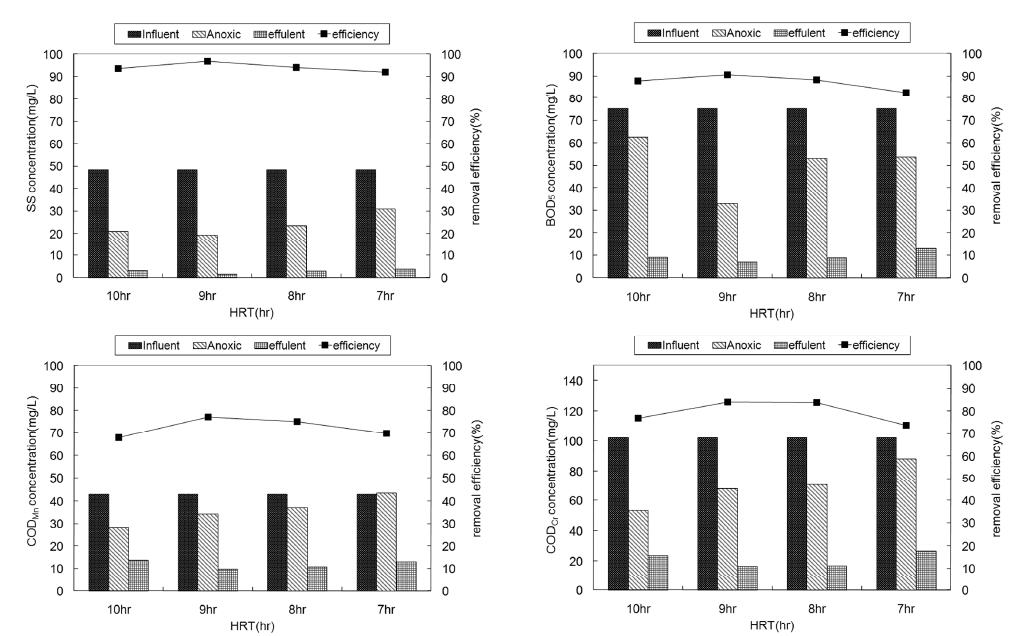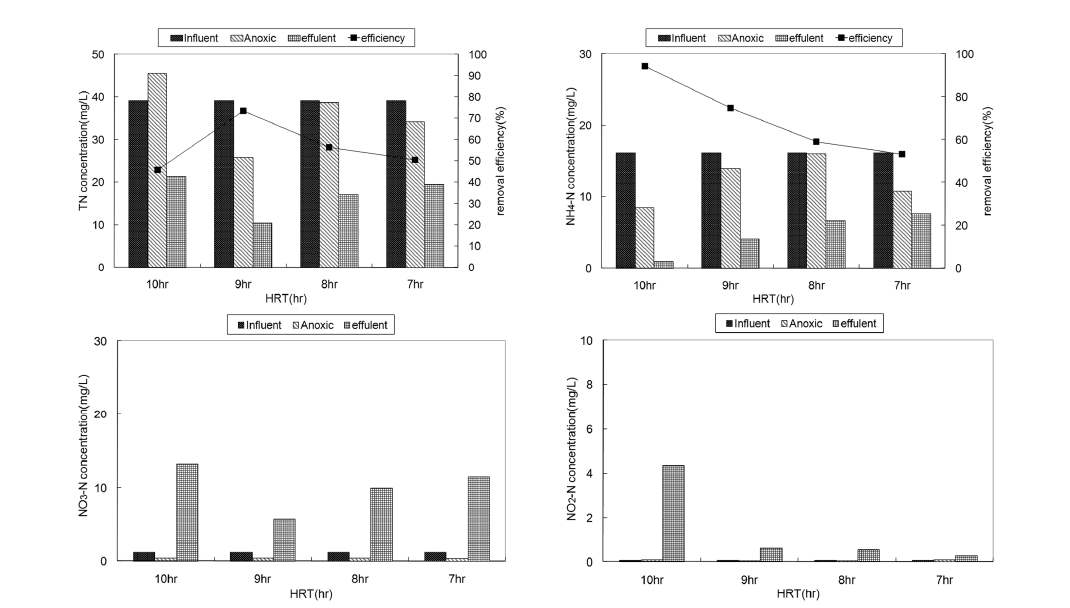


Compared to the activated sludge process and its derivatives, the biofilm process offers higher treatment efficiency with easier operation and high microorganism concentration per unit area as it is easier to maintain, consumes lower energy, can better resist against temperature, pH and hydraulic shock load, can treat the hard-to- decompose and prevent floating of the sludge due to bulking. Furthermore, the process can be effective in eliminating the nutrients since the anaerobic, aerobic, facultative microorganisms can coexist, and it can be used in the advanced treatment process that simultaneously removes the nitrogen and phosphorous at the same time as nitrification/denitrification reactions, which removes nitrogen and phosphorous, occurs inside the biofilm. However, the process has significant limitations despite such impressive benefits. The fixed biofilm filter requires elaborate backwashing technology, and the flexible reactor requires advanced technology in structural design as well as the air supply and inlet water distribution systems.
There are various commercial processes of biologically remo-ving nitrogen and phosphorous worldwide. They include A2/0, Bardenpho, VIP, UCT and others which involve the anaerobic and anoxic reactor operation using the organisms in the sewage which is in continuous contact with the aeration tank; and Phostrip which produces the organisms through the cell decomposition by retaining some of the returned sludge of the secondary settling pond in the anaerobic reactor, such as the sludge thickener, for long period and then uses them as the carbon source. However, these technologies were developed in the countries where sewer system is well advanced.1,2) For the countries such as Korea in which the sewage collection system mostly involves combined sewer overflows, the amount of organic materials in the sewage is far short of what is needed, and it has been considered that simultaneous removal of nitrogen and phosphorous is not feasible.
The final objective of this study was to develop the system which contained sufficient quantity of various types of microorganism groups; could resists against hydraulic shock load; offered high efficiency in low-power backwashing; simultaneously removed the organic materials, nitrogen and phosphorous; and did not require the secondary settler.
As the result, InSub(Indirectly Aerated Submerged Biofiltration ; InSub) system which satisfied all of the criteria mentioned above was developed. The Insub System is a combination of biofiltration technology using the submerged floating media substance with low gravity and indirect aerobic reactor which recycles water through airlift.
Therefore, the objective of this study was to determine optimum HRT which was first step in operation condition for effluent standard which would be strengthened from now on.
To be more practical, the system had to go through two evaluation processes. The first was a lab test to assess if the system can be used as the advanced treatment process. Through the lab test, however, we concluded that the anoxic and anaerobic reactors had to be combined for the simultaneous removal of nitrogen and phosphorous. The InSub System was developed as the result of it. The second involved the assessment of the system as the actual advanced treatment facility through a field test.
The pilot plant of InSub system which consist of InSub tank with a effective volume of 4.5 m3 and anaerobic/anoxic tank with the same volume for removing organic material and nutrients was installed at the J sewage treatment plant as shown in Fig. 1 and photo 1.
The diameter of InSub is 1.5 m and 0.25 m and height of that is 3.3 m and 2 m with a double tube, respectively. And if air is sparged in the draught-tube, the gas holdup in zones with gas and without gas results in different bulk density of the fluid in these regions which cause circulation of the fluid in the tank by a gas-lift action. Therefore this circulation offered attachedmicrobe optimum growth condition and was able to result in filtering by biofilm with packing porous and light media.3) Anaerobic microbe was also able to attach with the same packing media in the anaerobic/anoxic tank. The media packing ratio of tank was 20% in the anaerobic/anoxic and InSub, respectively. Media used in this study was sponge of the porous abrasion resistance ether polyurethane which was 20 mm of cube. And porosity was more than 95% and specific gravity was 0.04±0.01.
Experiment carried out variation of HRT. For determining optimum HRT, superficial velocity was 3.18 m/min, packing ratio of media was 20% and HRT carried out in order of 10 hr, 9 hr, 8 hr, 7 hr. Each sample analyzed when effluent reached steady state as shown Table 1.
According to Table 1, compared to a study that conducted by J. M. Glvez etc., it was aerated with 7.8∼43.5 m3/m2h, it is known that a research was conducted considerably with low-power when eliminating nitrogen, it took about 4 days to reach normal state in the present study and it took about 13 days in other study, it is considered that it shows characteristics of InSub equipment frankly.4) Table 2 showed analytical items and methods and table 3 showed composition of sewage used in this study and BOD/ T-N and BOD/T-P ratio was 1.9 and 27.8, respectively.
[Table 1] Operating conditions in this study
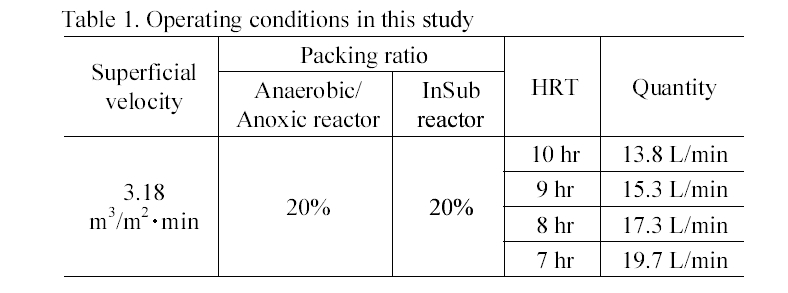
Operating conditions in this study
[Table 2.] Analytical items and methods
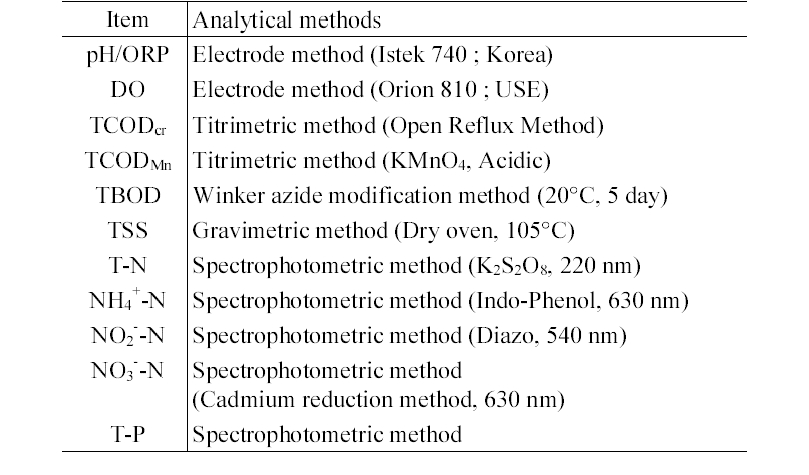
Analytical items and methods
[Table 3.] Composition of the sewage used in this study
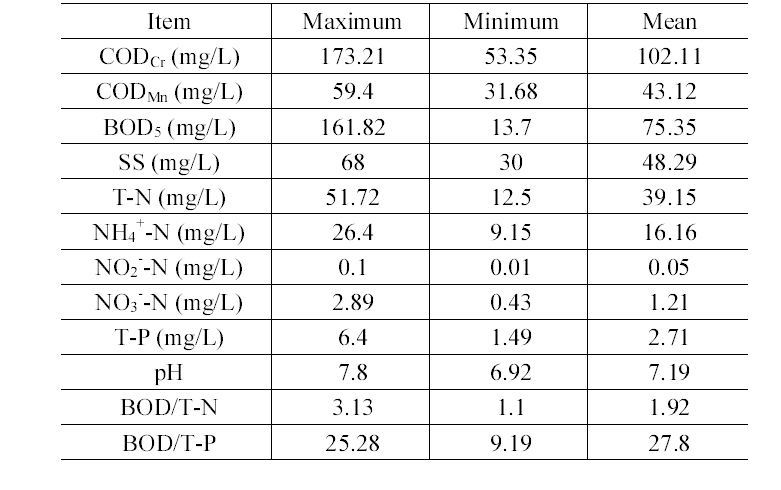
Composition of the sewage used in this study
3.1. Microorganism that Appeared in Pilot Plant
Among microorganism generated during operating a Pilot plant, conspicuous microorganism is Aeolosomagenus and Haliscomenobacter hydrossis like below photograph. Aeolosomagenus belongs to Aeolosomatidaev family, size isabout 1 mm and it contains oil drops that have red, yellow and green etc. hypodermically. Because oil drop of A.hemprichi that appears in biological treatment is red, it is easy to distinguish with other species. As food source, it mainly intakes bacteria and microorganism. The present genus mostly appears in activated sludge and biofitration that aerates for a long time. It is reported that if the present genus is dominant, activated sludge has red color and density of sludge is higher based on a fact that treated water BOD5 is below 10e i and SVI is lower than 100 when the present genus appears 1,000 per each activated sludge 1 mL and good quality of water is obtained if it coexists with other microorganism. The present genus often appears in activated sludge and biofitration in large quantity nitrification, nitrification progresses enough at this time and it is reported that there are many cases that Arcella genus, Carchesium genus and Macrobiotus genus etc. are observed at the same time.5,6)
Haliscomenobacter hydrossis is filamentous fungus and it is observed in activated sludge of low organic materials load, NH4+ and NO3- are used as nitrogen source but its propagation is facilitated by organism's nitrogen source and it did not largely have an effect on quality of effluent.7-9
An experiment was started from HRT 10 hr, an experiment was carried out in a method to lower HRT gradually from when 1 day passed after redc rng a steady state after seeding microorganism to InSub system. Ater redc rn, inic al SS concentration of effluenttarted ed in low concentration as 1.0 mg/L, average concentration was 3.10 mg/L and it showafter seremoval efficiency was 93.58%. Also inic al SS concentration of effluenttat HRT 9 hrtarted ed as low concentration as 0.5 mg/L, average concentration 1.46 mg/L and elimination efficiency showaft 96.98%, low cb rt efficiency. Inanism of HRT 8 hrtand 7 hr, concentration of effluenttwas 2.83 mg/L and 3.83 mg/L, eremoval efficiency was edc t94.14% and 92.07% and showaft rd avalue undertall condic on. It showst rd aelimination efficiency undertall operation condic on likent re, on ow coedin hand, it is known ow seeding microorgadllfingnces compa ed wit aLee (2002) effl and Kwon (2003) eftc.10,11)
Also compared to a new method of bio-filtration method developed domestically, InSub system shows very high removal efficiency. This is advantage in InSub equipment, internal circu lation occurs by rising stream in internal tube generated by aeration and it is considered that it shows high removal efficiency because it is removed repetitively by outside deposition biofitration due to this internal circulation.
Also, Fig. 2 showed BOD5, CODMn and CODCr concentration and removal efficiency for organic materials of influent in the anaerobic/anoxic tank and InSub tank to examine organic materials concentration and removal efficiency with variation of HRT.
With respect to effluent concentration and removal efficiency in each item at HRT 9hr that showed the highest removal efficiency, 7.09 mg/L and 90.59% in BOD5, 9.84 mg/L and 77.18% in CODMn and 16.42 mg/L and 83.92% in CODCr. The removal efficiency appeared comparatively similarly at HRT 9 hr and 8 hr, on the other hand, that was low at 10 hr and 7 hr relatively.
3.3. The Variations of Concentration and Removal Efficiency for Nitrogen
In the present research, it is a system that can remove organic materials and nitrogen at the same time by crossing anoxic and aerobic condition. It showed low removalefficiency because internal recycling did not occur under experiment condition according to HRT but high removal efficiency appeared compared with activated sludge process without internal recycling because unaerobic and aerobic condition that is advantage of biofiltration exists in one reactor at the same time.12
Concentration of effluent and removal efficiency of T-N and NH4 +-N at HRT 9 hr, it showed comparatively high removal efficiency of each 10.42 mg/L and 4.08 mg/L, 73.38% and 74.75% under condition that there is no internal recycling. It was considered that it showed the highest removal efficiency at HRT 10 hr when removal efficiency of NH4 +-N was the highest but nitrification occured many times and denitrification appeared relatively in low frequency like Fig. 3. In accordance with Han (1999) and Huh (2002) etc. in case that frequency of nitrification was higher than that of denitrification relatively, removing of organic materials and T-N removal efficiency became low and a result showed that removing of organic materials and T-N removal efficiency became low in case that HRT was 10 hr in the present study.13,14) According to Jeill Oh etc. (1999), nitrate accumulates when carbon source was scarce and similar phenomenon appeared at HRT 10 hr in the present research.15) Therefore, it was known that HRT was an important effect factor in elimination of T-N and organic materials.
3.4. The Variations of Concentration and Removal Efficiency for Phosphorus
Principle to eliminate phosphorus biologically is that removing phosphorus by releasing phosphorus in surplus sludge form after intaking phosphorus released in anaerobic process inside microorganism's cell in aerobic process. It was known that effect factors to participate in release and uptake of phosphorus were concentration of organic materials, concentration of DO and NO3- -N, pH, ORP (oxidation reduction potential), temperature, SRT etc. removal efficiency of T-P increases little as HRT
increases but it showed very low removal efficiency. Also it showed tendency that removal efficiency declined at HRT 10 hr. InSub system used in the present experiment, nitrification occurred in the upper and media surface and denitrification occurs at the lower part and inside media, it was designed that nitrification and denitrification are carried out at the same time.
According to Fig. 3, it was considered that release of phosphorus was inhibited because of an effect of oxidized nitrogen that was generated in a nitrification process, not removed by denitrification and remained in a reactor.16) Therefore, higher phosphorus elimination was expected in case that biological denitirfication through internal recycling to anoxic tank carried out side by side to remove oxidized nitrogen, inhibition factors to remove phosphorus.
The InSub System(applied for a patent) was developed, as it combined the indirectly aerated submerged biofitration(InSub) reactor and anaerobic/anoxic reactor. This system which can remove organism and nutrient materials at the same time, which was safe and economical to be maintained and managed was more simple process than the complicated existing biological advanced sewage treatment system.
In this study, it looked into the characteristics of organics, nitrogen and phosphorus removal with HRT for advanced sewage treatment in field plant experiment by InSub system for the commercialization of this system. It reached to the following results:
1. Among microorganism generated during operating a Pilot plant, conspicuous microorganism wss Aeolosomagenus and Haliscomenobacter hydrossis and as looking into SS concentration and the removal efficiency with each HRT under all operation conditions, it was kept that SS concentration was below 3.83 mg/L on the average, and it showed that the removal efficiency was over 92.07%.
2. It showed that the removal efficiency of organics on each HRT was similar. However, the removal efficiency was the highest at 9 hours of HRT.
3. It showed that the removal efficiency of the nutrient materials was similar both T-P and T-N. However, the highest removal efficiency was shown at 9 hours of HRT.
4. Therefore, it was decided that the most suitable HRT of this study is 9 hours. As looking into the effluent concentration and removal efficiency of each item at 9 hours of HRT, each effluent concentration for SS, BOD5, CODMn, and CODCr was 1.46 mg/L, 7,09 mg/L, 9.84 mg/L and 16.42 mg/L. And their removal efficiency was 96.98%. 90.59%, 77.18% and 83.92%, respectively. Each effluent concentration of T-N and T-P was 10.42 mg/L and 1.04 mg/L. Their removal efficiency was 73.38% and 61.62%, respectively.
5. This pilot plant experiment(the state was without the internal recycling.) followed a variety of HRT. The results confirmed that it was to be advanced sewage treatment system with high efficiency when it combined the internal recycling.
